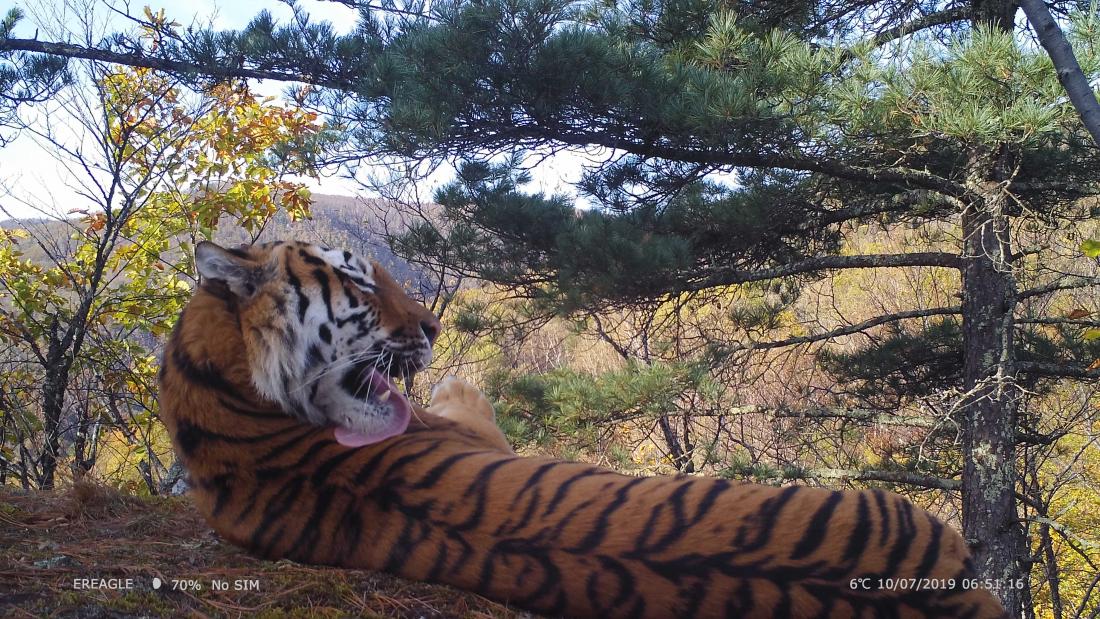- The next global hotspot for wild tigers could be in China
- Extensive land-use planning, improved habitat connectivity, restoration of prey, and reduction of human impacts are needed to restore tigers in four key landscapes
- International Tiger Day is Thursday, July 29th
An international team of scientists say that tigers could come roaring back in an unlikely place: northeastern China.
Scientists from Northeastern Forest University in Harbin, China, Wildlife Conservation Society (WCS), UC Davis, Amur Tiger National Reserve, World Wildlife Fund, and other groups recently published their results in the journal Biological Conservation, and say that four major forested landscapes – Laoyeling, Zhang-Guangcailing, Wandashan and the Lesser Khinghan Mountains may be able to support more than 300 Amur tigers (Panthera tigris altaica) including 119 breeding females. .
China has already made considerable progress in recent years to restore these iconic big cats with at least 55 individuals identified in recent surveys. To achieve the goal of 300-plus tigers in China, the authors say that large prey species, such as red deer and wild boar, need to be restored, along with extensive land-use planning, improving connectivity of habitat, reducing negative human impacts, and extensive international cooperation. In addition, a feasibility assessment is needed for reintroduction of tigers from other sources as a means of speeding recovery in landscapes without breeding females.
As many as 500 Amur tigers roamed throughout northeast China as late as the 1930s. However, by 2000, due to loss of habitat and prey combined with poaching, there are no more than 12~16 Amur tigers found along the border with Russia. Since then, the Natural Forest Protection Project halted logging over much of the region and led to the relocation of forest workers out of the region. The creation of nature reserves, improved anti-poaching efforts, and compensation for human-tiger conflicts have further helped to ease the pressures facing tigers in northeast China.
Camera trap surveys from 2013 to 2018 detected a total of 55 individual tigers in the four forest landscapes in Northeast China, with an increase from 7 individuals in 2013 to 33 individuals in 2018. During this same period, at least 20 cubs were born in northeast China. Amur tigers are distribute across 47813km2 in four major landscapes, but the vast majority are found in the Laoyeling Landscape, where the Chinese government recently created the Northeast Tiger Leopard National Park along the border with Russia. At 14,600 km2 , this park represents the largest protected area for tigers in the world.
Guangshun Jiang, the leading author of the paper, said: “It is clear that there is still a long way to go to realize a viable future for tigers in northeast China and northeast Asia. We need to build a meta-population of tigers connected across all 4 major forest landscapes in China, creating source populations in Chinese protected areas. There are many obstacles, but the opportunities have never been better. While there are still great ecological, social and political challenges, the science and political will to resolve these problems has also never been greater.”
Said Dale Miquelle, WCS Tiger Coordinator who has worked in both Russia and China and is a co-author of the study: National leaders of both Russia and China have demonstrated a sincere interest in Amur tiger conservation, providing a strong foundation for their recovery across the region. In China, there is still a need to restore prey populations, create a permeable landscape of well-connected habitat and compatible human land uses, strengthen trans-boundary habitat connectivity, and focus on those threats that are suppressing tiger numbers today. With trans-boundary cooperation allowing movement of tigers across the international border in multiple locations, there is the opportunity for a dramatic recovery of tigers in northeast China.”
International Tiger Day is on Thursday, July 29th.
Media contacts:
Mary Dixon, +1 347-840-1242, [email protected]
Max Pulsinelli, +1 571 218 7601; [email protected]
WCS (Wildlife Conservation Society)
MISSION: WCS saves wildlife and wild places worldwide through science, conservation action, education, and inspiring people to value nature. To achieve our mission, WCS, based at the Bronx Zoo, harnesses the power of its Global Conservation Program in nearly 60 nations and in all the world’s oceans and its five wildlife parks in New York City, visited by 4 million people annually. WCS combines its expertise in the field, zoos, and aquarium to achieve its conservation mission. Visit: newsroom.wcs.org Follow: @WCSNewsroom. For more information: 347-840-1242.
Feline Research Center of National Forestry and Grassland Administration
MISSION: Given the major requirement by endangered feline conservation and research worldwide, to conduct basic research and application research, carry out the work like international advanced technology exchange and cooperation, endangered feline population dynamic monitoring, conservation project design and planning, protection policy consultation, etc. To constructe an international information exchange platform for feline conservation, research and technology. CONTACT: Guangshun Jiang: Telephone (Fax): 0086+0451-82190279; Email: [email protected].



